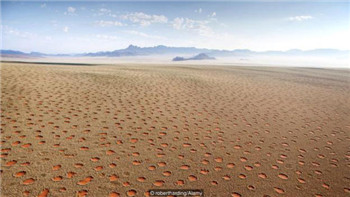
Across the arid grasslands of the Namib Desert lies an eerie sight: millions of circular patches of land void of plants, each between 2m and 15m in diameter, arranged in a honeycomb-like pattern across 2,500km of land. These disks of bare soil, known as fairy circles, pockmark the landscape in Namibia, as if giant moths ate through the vast carpets of grassland.
在荒芜的纳米布沙漠中,有一样怪异的景观:在寸草不生的土地上有数百万的圆形补丁,每每相隔2到15米的直径,在纵横2500千米的沙漠中聚集成蜂巢形状。在纳米比亚,这些被称为精灵圈的沙碟塑造出凹痕景观,就好像巨型蛾子在大片沙漠毯子上肆虐吞食。
Adding to the mystery, no one knows for certain what causes these otherworldly formations, writes Quora user Prem Rathaur. But there’s no shortage of theories.
更为神秘的是,没有人知道这鬼斧神差般杰作的成因,Quora用户普雷姆•拉索尔这样写道。但是一直有很多关于它的理论。
Scientists have suggested radioactive soil, or that toxins released from plants kills the vegetation in circular patterns. Others believe the circles are the work of sand termites. To store water, they burrow in the soil in ring-like patterns and consume the roots of vegetation to allow underlying grains of sand to absorb falling rain.
科学家们考虑过是放射性土壤导致的,或者是某种植物释放的毒素杀死了圆形植被造成的。有人则认为是沙地中的白蚁捣的鬼。为了储存水,他们在土壤中挖出环状凹坑,吮食植物根茎,以便下层沙粒能够吸收降水。
Another hypothesis ascribes the circles to competition for resources. In harsh landscapes, plants compete for water and nutrients. As weaker plants die and stronger ones grow, vegetation “self-organizes” into unusual patterns.
另一种猜测认为这些环状物与资源争夺相关。在艰苦的条件下,植物为水分和养分而相互争斗。在适者生存的过程中,植被自我调节到这种不寻常的模式。
Considering the eerie beauty of these phenomena, perhaps the most fitting theory is that of local bushmen, who say fairy circles are nothing less than the footprints of gods.
而对于这怪异而美丽的自然现象,大概能给出最合适的解释的是当地的布须曼人——他们说精灵圈是上帝的脚印。












